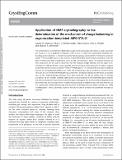Application of NMR crystallography to the determination of the mechanism of charge-balancing in organocation-templated AlPO STA-2
View/
Date
07/2013Author
Grant ID
EP/E041825/1
EP/J501542/1
EP/J501542/1
EP/F018096/1
EP/J501542/1
Metadata
Show full item recordAbstract
The combination of solid-state MAS NMR spectroscopy and first-principles calculations is used to elucidate the structure of an as-prepared microporous AlPO (STA-2), in which the organocation template (bis-diazabicyclooctane-butane) is charge balanced by hydroxyl groups coordinated to framework aluminium species. 27Al MAS NMR spectra show Al exists in both tetrahedral and five-fold coordination, with the latter directly coordinated to hydroxyl O atoms as well as framework O atoms. The relative intensities of these resonances can be used to determine that the hydroxyls bridge between the two types of Al. Calculation of NMR parameters using a periodic density functional theory approach are able to suggest assignments for the resonances in both 27Al and 31P NMR spectra. 31P chemical shifts are shown to depend not only on the topologically-distinct sites in the SAT framework but also on whether or not the P atoms form part of a six-membered P(OAl)2OH ring, where OH is a bridging hydroxyl. By diffraction six possible sites for the charge-balancing hydroxyls have been identified, but all are refined with an average occupancy of 0.33. However, predicted peak positions in two-dimensional J-HETCOR NMR spectra indicate that only one hydroxyl is found in each cancrinite cage, and suggest that the most likely arrangements are those that avoid the close approach of bridging hydroxyl groups in adjacent cages. We show that the use of a combination of NMR spectroscopy and calculation to elucidate structure, often referred to as “NMR Crystallography”, offers a promising route for the future study of as-made and substituted microporous materials.
Citation
Seymour , V R , Eschenroeder , E C V , Jimenez-Castro , M , Wright , P A & Ashbrook , S E 2013 , ' Application of NMR crystallography to the determination of the mechanism of charge-balancing in organocation-templated AlPO STA-2 ' , CrystEngComm , vol. Advance . https://doi.org/10.1039/C3CE40965A
Publication
CrystEngComm
Status
Peer reviewed
ISSN
1466-8033Type
Journal article
Collections
Items in the St Andrews Research Repository are protected by copyright, with all rights reserved, unless otherwise indicated.
Related items
Showing items related by title, author, creator and subject.
-
Unusual intermolecular “through-space” J couplings in P–Se heterocycles
Sanz Camacho, Paula; Athukorala Arachchige, Kasun Sankalpa; Slawin, Alexandra Martha Zoya; Green, Timothy F.G.; Yates, Jonathan R.; Dawson, Daniel McLean; Woollins, J Derek; Ashbrook, Sharon Elizabeth (2015-05-20) - Journal articleSolid-state NMR spectra of new P–Se heterocycles based on peri-substituted naphthalene motifs show the presence of unusual J couplings between Se and P. These couplings are between atoms in adjacent molecules and occur ... -
Controlling the electromagnetic proximity effect by tuning the mixing between superconducting and ferromagnetic order
Stewart, R.; Flokstra, M. G.; Rogers, M.; Satchell, N.; Burnell, G.; Miller, D.; Luetkens, H.; Prokscha, T.; Suter, A.; Morenzoni, E.; Lee, S. L. (2019-07-12) - Journal articleWe present low-energy muon-spin rotation measurements on Cu/Nb/AlOx/Co thin films that probe the newly described electromagnetic (EM) proximity effect. By varying the thickness of the insulating AlOx layer we control the ... -
Switching on electrocatalytic activity in solid oxide cells
Myung, Jaeha; Neagu, Dragos; Miller, David N.; Irvine, John T. S. (2016-09-22) - Journal articleSolid oxide cells (SOCs) can operate with high efficiency in two ways—as fuel cells, oxidizing a fuel to produce electricity, and as electrolysis cells, electrolysing water to produce hydrogen and oxygen gases. Ideally, ...

